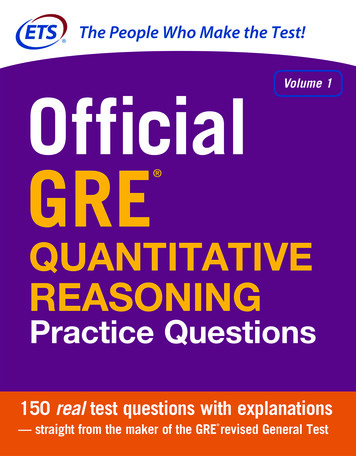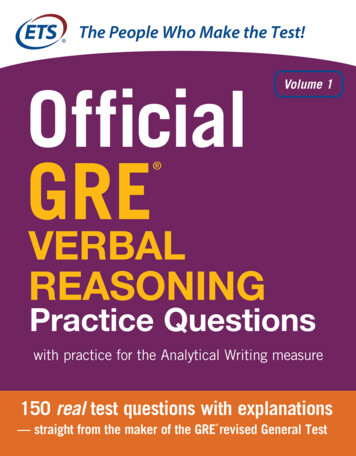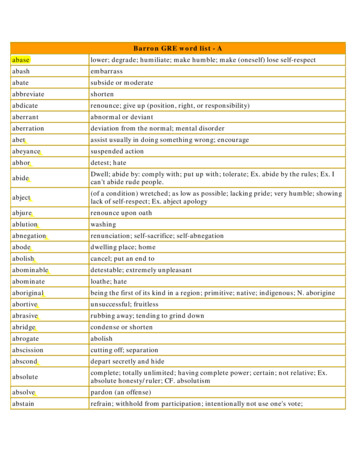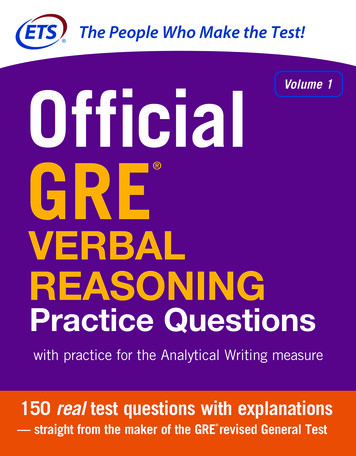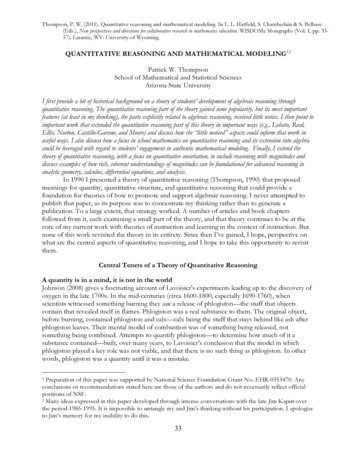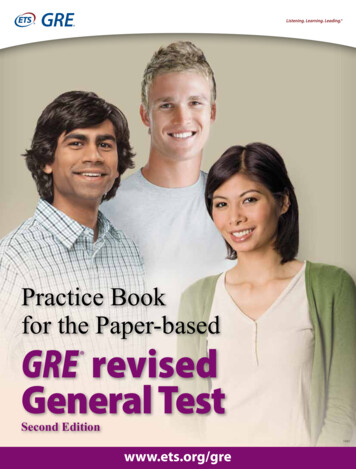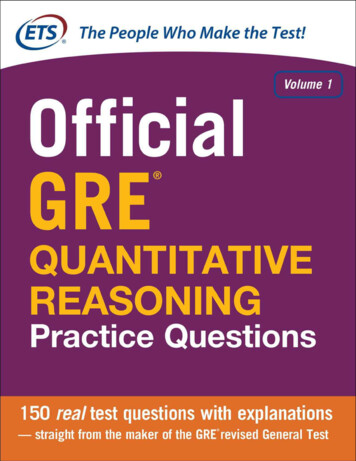
Transcription
Welcome toOfficial GRE Quantitative Reasoning Practice Questions,Volume 1The book you are holding offers 150 real GRE practice questions directly from the maker of theGRE revised General Test. This book is specially created to give you in-depth practice andaccurate test preparation for the Quantitative Reasoning measure.Here’s what you will find inside: Authentic GRE Quantitative Reasoning test questions arranged by content and questiontype—to help you build your test-taking skills. Plus, mixed practice sets. Answers and explanations for every question! ETS’s own test-taking strategies. Learn valuable hints and tips that can help you get yourbest score. GRE Math Review covering math topics you need to know for the test. Official information on the GRE Quantitative Reasoning measure. Get the facts about thetest content, structure, scoring, and more—straight from ETS.About ETSAt ETS, we advance quality and equity in education for people worldwide by creatingassessments based on rigorous research. ETS serves individuals, educational institutions, andgovernment agencies by providing customized solutions for teacher certification, Englishlanguage learning, and elementary, secondary, and post-secondary education, as well asconducting educational research, analysis, and policy studies. Founded as a nonprofit in 1947,ETS develops, administers, and scores more than 50 million tests annually—including theTOEFL and TOEIC tests, the GRE tests, and The Praxis SeriesTM assessments—in more
than 180 countries at over 9,000 locations worldwide.For more information, visit www.ets.org.
IMPORTANTETS makes available free test preparation materials for individuals planning to take a GRE test.POWERPREP II software is available for individuals planning to take the computer-delivered GRErevised General Test, and the Practice Book for the Paper-based GRE revised General Test,Second edition, is available for individuals planning to take the paper-delivered test. The informationabout how to prepare for the Quantitative Reasoning measure of the GRE revised General Test,including test-taking strategies, question strategies, etc., that is included in the free test preparation isalso included in this publication. This publication also provides you with 150 brand new practicequestions with answers and explanations.For more information about the GRE revised General Test, free and low-cost GRE testpreparation materials, and other GRE products and services, please visit the GRE website at:www.ets.org/greInquiries concerning the practice test questions in this book should be sent to the GRE testingprogram at:GRETestQuestionInquiries@ets.org
Copyright 2014 by Educational Testing Service. All rights reserved. Except as permitted under theUnited States Copyright Act of 1976, no part of this publication may be reproduced or distributed inany form or by any means, or stored in a data base or retrieval system, without the prior writtenpermission of the publisher.ISBN: 978-0-07-183431-5MHID:0-07-183431-1The material in this eBook also appears in the print version of this title: ISBN: 978-0-07-183432-2,MHID: 0-07-183432-X.eBook conversion by codeMantraVersion 1.0All trademarks are trademarks of their respective owners. Rather than put a trademark symbol afterevery occurrence of a trademarked name, we use names in an editorial fashion only, and to the benefitof the trademark owner, with no intention of infringement of the trademark. Where such designationsappear in this book, they have been printed with initial caps.McGraw-Hill Education eBooks are available at special quantity discounts to use as premiums andsales promotions or for use in corporate training programs. To contact a representative, please visitthe Contact Us page at www.mhprofessional.com.ETS, the ETS logo, LISTENING, LEARNING, LEADING, E-RATER, GRADUATE RECORDEXAMINATIONS, GRE, POWERPREP, SCORESELECT, TOEFL, and TOEIC are registeredtrademarks of Educational Testing Service in the United States and other countries and are used underlicense. THE PRAXIS SERIES is a trademark of Educational Testing Service and is used underlicense.TERMS OF USEThis is a copyrighted work and McGraw-Hill Education and its licensors reserve all rights in and tothe work. Use of this work is subject to these terms. Except as permitted under the Copyright Act of1976 and the right to store and retrieve one copy of the work, you may not decompile, disassemble,reverse engineer, reproduce, modify, create derivative works based upon, transmit, distribute,disseminate, sell, publish or sublicense the work or any part of it without McGraw-Hill Education’sprior consent. You may use the work for your own noncommercial and personal use; any other use ofthe work is strictly prohibited. Your right to use the work may be terminated if you fail to complywith these terms.THE WORK IS PROVIDED “AS IS.” MCGRAW-HILL EDUCATION AND ITS LICENSORSMAKE NO GUARANTEES OR WARRANTIES AS TO THE ACCURACY, ADEQUACY ORCOMPLETENESS OF OR RESULTS TO BE OBTAINED FROM USING THE WORK,INCLUDING ANY INFORMATION THAT CAN BE ACCESSED THROUGH THE WORK VIAHYPERLINK OR OTHERWISE, AND EXPRESSLY DISCLAIM ANY WARRANTY, EXPRESSOR IMPLIED, INCLUDING BUT NOT LIMITED TO IMPLIED WARRANTIES OFMERCHANTABILITY OR FITNESS FOR A PARTICULAR PURPOSE. McGraw-Hill Educationand its licensors do not warrant or guarantee that the functions contained in the work will meet yourrequirements or that its operation will be uninterrupted or error free. Neither McGraw-Hill Educationnor its licensors shall be liable to you or anyone else for any inaccuracy, error or omission,
regardless of cause, in the work or for any damages resulting therefrom. McGraw-Hill Education hasno responsibility for the content of any information accessed through the work. Under nocircumstances shall McGraw-Hill Education and/or its licensors be liable for any indirect,incidental, special, punitive, consequential or similar damages that result from the use of or inabilityto use the work, even if any of them has been advised of the possibility of such damages. Thislimitation of liability shall apply to any claim or cause whatsoever whether such claim or causearises in contract, tort or otherwise.
ContentsHow to Use This Book1 Overview of the GRE Quantitative ReasoningMeasureIntroduction to the GRE revised General TestThe Quantitative Reasoning Measure of the Computer-delivered GRE revised General TestThe Quantitative Reasoning Measure of the Paper-delivered GRE revised General TestScore Reporting2 Test ContentOverview of the Quantitative Reasoning MeasureGeneral Problem-solving StepsQuantitative Reasoning Question TypesUsing the Calculator3 ArithmeticQuantitative Comparison QuestionsMultiple-choice Questions—Select One Answer ChoiceMultiple-choice Questions—Select One or More Answer ChoicesNumeric Entry Questions
Answer KeyAnswers and Explanations4 AlgebraQuantitative Comparison QuestionsMultiple-choice Questions—Select One Answer ChoiceMultiple-choice Questions—Select One or More Answer ChoicesNumeric Entry QuestionsAnswer KeyAnswers and Explanations5 GeometryQuantitative Comparison QuestionsMultiple-choice Questions—Select One Answer ChoiceMultiple-choice Questions—Select One or More Answer ChoicesNumeric Entry QuestionsAnswer KeyAnswers and Explanations6 Data AnalysisQuantitative Comparison QuestionsMultiple-choice Questions—Select One Answer ChoiceMultiple-choice Questions—Select One or More Answer ChoicesNumeric Entry QuestionsData Interpretation SetsAnswer KeyAnswers and Explanations7 Mixed Practice SetsPractice Set 1Answer KeyAnswers and ExplanationsPractice Set 2
Answer KeyAnswers and ExplanationsPractice Set 3Answer KeyAnswers and ExplanationsAppendix A: GRE Math Review1. Arithmetic2. Algebra3. Geometry4. Data AnalysisAppendix B: Mathematical Conventions for the QuantitativeReasoning Measure of the GRE revised General Test
How to Use This BookThis book provides important information about the Quantitative Reasoning measure of the GRErevised General Test, including the knowledge and skills that are assessed and the types ofquestions that appear. The book will help you: Familiarize yourself with the test format and test question typesLearn valuable test-taking strategies for each question typeReview the math topics you need to know for the testCheck your progress with Quantitative Reasoning practice questionsThe following four-step program has been designed to help you make the best use of this book.STEP 1 Learn About the GRE Quantitative ReasoningMeasureChapter 1 of this book provides an overview of the GRE Quantitative Reasoning measure. Readthis chapter to learn about the number of questions, time limits, and the test design features. Youwill also find valuable test-taking strategies from ETS and important information about how themeasure is scored.STEP 2 Study the Different GRE Quantitative ReasoningQuestion TypesChapter 2 of this book describes the types of questions you will encounter in the QuantitativeReasoning measure. You will learn what the questions are designed to measure, and you will gettips for answering each question type. You will also see samples of each question type, withhelpful explanations.STEP 3 Practice Answering GRE Quantitative ReasoningQuestionsChapters 3, 4, 5, and 6 contain sets of authentic Quantitative Reasoning practice questions in thecontent areas of Arithmetic, Algebra, Geometry, and Data Analysis, respectively. Answer thequestions in each set, and then read through the explanations to see which questions you foundmost challenging. Look for patterns. Did specific content areas give you trouble? You can
refresh your math skills in these areas with the GRE Math Review in Appendix A. The GREMath Review is a review of the math topics that are likely to appear on the QuantitativeReasoning measure. Each section of the GRE Math Review ends with exercises that will helpyou see how well you have mastered the material. Note that Appendix B provides informationabout the mathematical conventions that are used on the Quantitative Reasoning measure. Priorto answering the practice questions, it might be helpful to review these conventions.STEP 4 Test Yourself With the Mixed Practice SetsOnce you have completed the practice sets for each content area in Chapters 3–6, it is time topractice with authentic GRE questions in the Mixed Practice Sets in Chapter 7. Each MixedPractice Set includes the question types and content areas contained in an actual QuantitativeReasoning section of the GRE revised General Test.
1Overview of the GRE QuantitativeReasoning MeasureYour goal for this chapterReview basic information on the structure of the GRE Quantitative Reasoning measure, testtaking strategies, and scoringIntroduction to the GRE revised General TestT he GRE revised General Test—the most widely accepted graduate admissions test worldwide—measures verbal reasoning, quantitative reasoning, critical thinking, and analytical writing skillsthat are necessary for success in graduate and business school.Prospective graduate and business school applicants from all around the world take the GRErevised General Test. Although applicants come from varying educational and cultural backgrounds,the GRE revised General Test provides a common measure for comparing candidates’ qualifications.GRE scores are used by admissions committees and fellowship panels to supplement undergraduaterecords, recommendation letters, and other qualifications for graduate-level study.The GRE revised General Test is available at test centers in more than 160 countries. In mostregions of the world, the computer-delivered test is available on a continuous basis throughout theyear. In areas of the world where computer-delivered testing is not available, the test is administeredin a paper-delivered format up to three times a year.Before taking the GRE revised General Test, it is important to become familiar with the contentand structure of the test, and with each of the three measures—Verbal Reasoning, QuantitativeReasoning, and Analytical Writing. This book provides a close look at the GRE QuantitativeReasoning measure. Chapter 1 provides an overview of the structure and scoring of the QuantitativeReasoning measure. In Chapters 2 through 7, you will find information specific to the content of theQuantitative Reasoning measure. You can use the information in this publication to help youunderstand the type of material on which you will be tested. For the most up-to-date information aboutthe GRE revised General Test, visit the GRE website at www.ets.org/gre.The Quantitative Reasoning Measure of the Computer-delivered
GRE revised General TestStructure of the Quantitative Reasoning MeasureThe Quantitative Reasoning sections may appear anytime in the test after section 1. The directions atthe beginning of each Quantitative Reasoning section specify the total number of questions in thesection and the time allowed for the section.Test Design FeaturesThe Quantitative Reasoning measure of the computer-delivered GRE revised General Test is sectionlevel adaptive. This means the computer selects the second section of a measure based on yourperformance on the first section.The advanced adaptive design also means you can freely move forward and backward throughoutan entire section. Specific features include: Preview and review capabilities within a section “Mark” and “Review” features to tag questions, so you can skip them and return later if you havetime remaining in the section The ability to change/edit answers within a section An on-screen calculator (More information about the calculator is given in Chapter 2.)Test-taking StrategiesThe questions in the Quantitative Reasoning measure are presented in a variety of formats. Somerequire you to select a single answer choice, others require you to select one or more answer choices,and yet others require you to enter a numeric answer. Make sure when answering a question that youunderstand what response is required. An on-screen calculator will be provided at the test center foruse during the Quantitative Reasoning sections.When taking the Quantitative Reasoning measure of the computer-delivered GRE revised GeneralTest, you are free to skip questions that you might have difficulty answering within a section. Thetesting software has a “Mark” feature that enables you to mark questions you would like to revisitduring the time provided to work on that section. The testing software also has a “Review” featurethat lets you view a complete list of all the questions in the section on which you are working, thatindicates whether you have answered each question, and that identifies the questions you have markedfor review. Additionally, you can review questions you have already answered and change youranswers, provided you still have time remaining to work on that section.A sample review screen appears below. The review screen is intended to help you keep track ofyour progress on the test. Do not spend too much time on the review screen, as this will take away
from the time allotted to read and answer the questions on the test.Your Quantitative Reasoning score will be determined by the number of questions you answercorrectly. Nothing is subtracted from a score if you answer a question incorrectly. Therefore, tomaximize your scores on the Quantitative Reasoning measure, it is best to answer every question.Work as rapidly as you can without being careless. Since no question carries greater weight thanany other, do not waste time pondering individual questions you find extremely difficult or unfamiliar.You may want to go through each of the Quantitative Reasoning sections rapidly first, stoppingonly to answer questions you can answer with certainty. Then go back and answer the questions thatrequire greater thought, concluding with the difficult questions if you have time.During the actual administration of the revised General Test, you may work only on one section ata time and only for the time allowed. Once you have completed a section, you may not go back to it.Scratch Paper
You will receive a supply of scratch paper before you begin the test. You can replenish your supplyof scratch paper as necessary throughout the test by asking the test administrator.How the Quantitative Reasoning Measure Is ScoredThe Quantitative Reasoning measure is section-level adaptive. This means the computer selects thesecond section of a measure based on your performance on the first section. Within each section, allquestions contribute equally to the final score. First a raw score is computed. The raw score is thenumber of questions you answered correctly. The raw score is then converted to a scaled scorethrough a process known as equating. The equating process accounts for minor variations in difficultyfrom test to test as well as the differences introduced by the section-level adaptation. Thus a givenscaled score reflects the same level of performance regardless of which second section was selectedand when the test was taken.The Quantitative Reasoning Measure of the Paper-delivered GRErevised General TestStructure of the Quantitative Reasoning MeasureThe Quantitative Reasoning sections may appear in any order after section 2. The directions at thebeginning of each section specify the total number of questions in the section and the time allowed forthe section.Test Design Features You are free, within any section, to skip questions and come back to them later or change theanswer to a question. Answers are entered in the test book, rather than a separate answer sheet. You will be provided with an ETS calculator to use during the Quantitative Reasoning section; you may not use your own calculator.Test-taking StrategiesThe questions in the Quantitative Reasoning measure have a variety of formats. Some require you toselect a single answer choice, others require you to select one or more answer choices, and yet othersrequire you to enter a numeric answer. Make sure when answering a question that you understandwhat response is required. A calculator will be provided at the test center for use during theQuantitative Reasoning sections.
When taking a Quantitative Reasoning section, you are free, within that section, to skip questionsthat you might have difficulty answering and come back to them later during the time provided towork on that section. Also during that time you may change the answer to any question in that sectionby erasing it completely and filling in an alternative answer. Be careful not to leave any stray marksin the answer area, as they may be interpreted as incorrect responses. You can, however, safely makenotes or perform calculations on other parts of the page. No additional scratch paper will beprovided.Your Quantitative Reasoning score will be determined by the number of questions you answercorrectly. Nothing is subtracted from a score if you answer a question incorrectly. Therefore, tomaximize your score on the Quantitative Reasoning measure, it is best to answer every question.Work as rapidly as you can without being careless. Since no question carries greater weight thanany other, do not waste time pondering individual questions you find extremely difficult or unfamiliar.You may want to go through each of the Quantitative Reasoning sections rapidly first, stoppingonly to answer questions you can answer with certainty. Then go back and answer the questions thatrequire greater thought, concluding with the difficult questions if you have time.During the actual administration of the revised General Test, you may work only on the section thetest center supervisor designates and only for the time allowed. You may not go back to an earliersection of the test after the supervisor announces, “Please stop work” for that section. The supervisoris authorized to dismiss you from the center for doing so.All answers must be recorded in the test book.How the Quantitative Reasoning Measure Is ScoredScoring of the Quantitative Reasoning measure is essentially a two-step process. First a raw score iscomputed. The raw score is the number of questions answered correctly in the two sections for themeasure. The raw score is then converted to a scaled score through a process known as equating. Theequating process accounts for minor variations in difficulty among the different test editions. Thus agiven scaled score reflects the same level of performance regardless of which edition of the test wastaken.Score ReportingA Quantitative Reasoning score is reported on a 130–170 score scale, in 1-point increments. If youdo not answer any questions at all for the measure, you will receive a No Score (NS) for thatmeasure.The ScoreSelect OptionThe ScoreSelect option is available for both the GRE revised General Test and GRE Subject Testsand can be used by anyone with reportable scores from the last five years. This option lets you sendinstitutions your best scores. For your four free score reports, you can send scores from your MostRecent test administration or scores from All test administrations in your reportable history. After testday, you can send scores from your Most Recent, All, or Any specific test administration(s) for a feewhen ordering Additional Score Reports. Just remember, scores for a test administration must be
reported in their entirety. For more information, visit www.ets.org/gre/scoreselect.Score Reporting Time FramesScores from computer-delivered GRE revised General Test administrations are reportedapproximately 10 to 15 days after the test date. Scores from paper-delivered administrations arereported within six weeks after the test date. If you are applying to a graduate or business schoolprogram, be sure to review the appropriate admissions deadlines and plan to take the test in time foryour scores to reach the institution.For more information on score reporting, visit the GRE website at www.ets.org/gre/scores/get.
2Test ContentYour goals for this chapterLearn general problem-solving steps and strategiesLearn the four types of GRE Quantitative Reasoning questions and get tips for answeringeach question typeStudy sample Quantitative Reasoning questions with solutionsLearn how to use the on-screen calculatorOverview of the Quantitative Reasoning MeasureT he Quantitative Reasoning measure of the GRE revised General Test assesses your: basic mathematical skills understanding of elementary mathematical concepts ability to reason quantitatively and to model and solve problems with quantitative methodsSome of the Quantitative Reasoning questions are posed in real-life settings, while others areposed in purely mathematical settings. Many of the questions are “word problems,” which must betranslated and modeled mathematically. The skills, concepts, and abilities are assessed in the fourcontent areas below.Arithmetic topics include properties and types of integers, such as divisibility, factorization,prime numbers, remainders, and odd and even integers; arithmetic operations, exponents, and roots;and concepts such as estimation, percent, ratio, rate, absolute value, the number line, decimalrepresentation, and sequences of numbers.Algebra topics include operations with exponents; factoring and simplifying algebraicexpressions; relations, functions, equations, and inequalities; solving linear and quadratic equationsand inequalities; solving simultaneous equations and inequalities; setting up equations to solve wordproblems; and coordinate geometry, including graphs of functions, equations, and inequalities,intercepts, and slopes of lines.Geometry topics include parallel and perpendicular lines, circles, triangles—includingisosceles, equilateral, and 30 -60 -90 triangles—quadrilaterals, other polygons, congruent andsimilar figures, three-dimensional figures, area, perimeter, volume, the Pythagorean theorem, and
angle measurement in degrees. The ability to construct proofs is not tested.Data analysis topics include basic descriptive statistics, such as mean, median, mode, range,standard deviation, interquartile range, quartiles, and percentiles; interpretation of data in tables andgraphs, such as line graphs, bar graphs, circle graphs, boxplots, scatterplots, and frequencydistributions; elementary probability, such as probabilities of compound events and independentevents; random variables and probability distributions, including normal distributions; and countingmethods, such as combinations, permutations, and Venn diagrams. These topics are typically taught inhigh school algebra courses or introductory statistics courses. Inferential statistics is not tested.The content in these areas includes high school mathematics and statistics at a level that isgenerally no higher than a second course in algebra; it does not include trigonometry, calculus, orother higher-level mathematics. The publication Math Review for the GRE revised General Test,which is available in Appendix A, provides detailed information about the content of the QuantitativeReasoning measure.The mathematical symbols, terminology, and conventions used in the Quantitative Reasoningmeasure are those that are standard at the high school level. For example, the positive direction of anumber line is to the right, distances are nonnegative, and prime numbers are greater than 1.Whenever nonstandard notation is used in a question, it is explicitly introduced in the question.In addition to conventions, there are some important assumptions about numbers and figures thatare listed in the Quantitative Reasoning section directions: All numbers used are real numbers. All figures are assumed to lie in a plane unless otherwise indicated. Geometric figures, such as lines, circles, triangles, and quadrilaterals, are not necessarily drawnto scale. That is, you should not assume that quantities such as lengths and angle measures are asthey appear in a figure. You should assume, however, that lines shown as straight are actuallystraight, points on a line are in the order shown, and more generally, all geometric objects are inthe relative positions shown. For questions with geometric figures, you should base your answerson geometric reasoning, not on estimating or comparing quantities by sight or by measurement. Coordinate systems, such as xy-planes and number lines, are drawn to scale; therefore, you canread, estimate, or compare quantities in such figures by sight or by measurement. Graphical data presentations, such as bar graphs, circle graphs, and line graphs, are drawn toscale; therefore, you can read, estimate, or compare data values by sight or by measurement.More about conventions and assumptions appears in the publication Mathematical Conventionsfor the GRE revised General Test, which is available in Appendix B.General Problem-solving StepsQuestions in the Quantitative Reasoning measure ask you to model and solve problems usingquantitative, or mathematical, methods. Generally, there are three basic steps in solving amathematics problem:Step 1: Understand the problemStep 2: Carry out a strategy for solving the problem
Step 3: Check your answerHere is a description of the three steps, followed by a list of useful strategies for solving mathematicsproblems.Step 1: Understand the ProblemThe first step is to read the statement of the problem carefully to make sure you understand theinformation given and the problem you are being asked to solve.Some information may describe certain quantities. Quantitative information may be given inwords or mathematical expressions, or a combination of both. Also, in some problems you may needto read and understand quantitative information in data presentations, geometric figures, or coordinatesystems. Other information may take the form of formulas, definitions, or conditions that must besatisfied by the quantities. For example, the conditions may be equations or inequalities, or may bewords that can be translated into equations or inequalities.In addition to understanding the information you are given, it is important to understand what youneed to accomplish in order to solve the problem. For example, what unknown quantities must befound? In what form must they be expressed?Step 2: Carry Out a Strategy for Solving the ProblemSolving a mathematics problem requires more than understanding a description of the problem, thatis, more than understanding the quantities, the data, the conditions, the unknowns, and all othermathematical facts related to the problem. It requires determining what mathematical facts to use andwhen and how to use those facts to develop a solution to the problem. It requires a strategy.Mathematics problems are solved by using a wide variety of strategies. Also, there may bedifferent ways to solve a given problem. Therefore, you should develop a repertoire of problemsolving strategies, as well as a sense of which strategies are likely to work best in solving particularproblems. Attempting to solve a problem without a strategy may lead to a lot of work withoutproducing a correct solution.After you determine a strategy, you must carry it out. If you get stuck, check your work to see ifyou made an error in your solution. It is important to have a flexible, open mind-set. If you check yoursolution and cannot find an error or if your solution strategy is simply not working, look for adifferent strategy.Step 3: Check Your AnswerWhen you arrive at an answer, you should check that it is reasonable and computationally correct. Have you answered the question that was asked? Is your answer reasonable in the context of the question? Checking that an answer is reasonablecan be as simple as recalling a basic mathematical fact and checking whether your answer isconsistent with that fact. For example, the probability of an event must be between 0 and 1,inclusive, and the area of a geometric figure must be positive. In other
The book you are holding offers 150 real GRE practice questions directly from the maker of the GRE . GRE Math Review covering math topics you need to know for the test. . For more information about the GRE revised General Test, free and low-cost GRE test preparation materials, and other GRE products and services, please visit the GRE .
